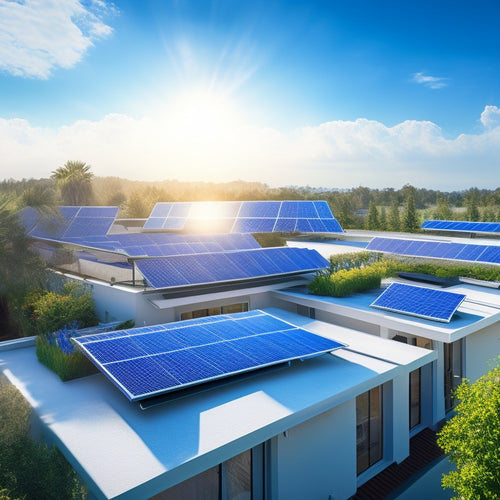
7 Essential Steps for Solar Panel Installation in California
Share
You're about to convert your California home into a clean energy hub, and it all starts with these 7 essential steps. First, assess your energy needs by reviewing past electricity bills and identifying peak usage periods. Next, choose a licensed installer with a CSLB license and NABCEP certification. Then, select the right equipment considering factors like efficiency ratings and warranty. Verify your roof is ready by inspecting its condition and structural integrity. Obtain necessary permits by complying with local building codes and submitting a detailed application. Install the solar system, and finally, inspect and activate it to start generating clean energy. As you follow these steps, you'll be revealing a world of solar possibilities.
Key Takeaways
- Assess your energy needs by reviewing past electricity bills and considering home size, occupant number, and appliance efficiency.
- Choose a licensed and certified installer with a physical address, insurance coverage, and a clear installation process.
- Select high-efficiency equipment with a good warranty, durability, and maintenance needs to ensure peak system performance.
- Ensure your roof is ready for installation by inspecting its condition, structural integrity, and assessing its age, slope, and orientation.
- Secure necessary permits by submitting a detailed application to your local government, ensuring compliance with local building codes and regulations.
Assess Your Energy Needs
Most California households consume around 500-700 kilowatt-hours (kWh) of electricity per month.
As you evaluate solar panel installation, it's crucial to analyze your energy needs to determine the right system size for your home. You'll want to review your past electricity bills to understand your energy consumption patterns. Look for the total kWh used per month, as well as the peak usage periods. This information will help you identify areas where you can optimize your energy usage and maximize your solar savings.
To get an accurate estimate, you'll need to reflect on factors like the size of your home, the number of occupants, and your appliances' energy efficiency.
You may also want to think about upgrading to energy-efficient appliances or lighting to reduce your overall energy consumption. By understanding your energy needs, you can design a solar panel system that meets your specific requirements, providing you with the most significant solar savings possible.
Choose a Licensed Installer
With your energy needs assessed, you're now ready to select a reputable and qualified solar panel installer to bring your system to life. This vital step guarantees your solar panel system is installed correctly, efficiently, and safely.
When choosing an installer, look for qualifications such as a California State License Board (CSLB) license, North American Board of Certified Energy Practitioners (NABCEP) certification, and a proven track record of successful installations.
Verify the installer's physical address, insurance, and workers' compensation coverage to protect yourself from potential liabilities. Additionally, ask about their installation timeline, including the project schedule, milestones, and expected completion date.
A reputable installer will provide a clear and realistic timeline, guaranteeing your project stays on track. Be wary of installers who can't provide these essential details or seem unclear about their process.
Select the Right Equipment
As you move forward with your solar panel installation, selecting the right equipment becomes a critical decision that directly impacts your system's performance and longevity. You'll need to choose from various equipment types, each with its own set of features, benefits, and drawbacks. To make an informed decision, consider the following factors:
| Equipment Type | Efficiency Rating |
| Monocrystalline Silicon | 20-22% |
| Polycrystalline Silicon | 15-18% |
| Thin-Film | 7-14% |
| Bifacial | 18-22% |
| Perovskite | 20-25% |
When evaluating equipment, look for high-efficiency ratings, as they directly impact your system's energy production. Additionally, consider the warranty, durability, and maintenance requirements of each equipment type. By selecting the right equipment, you'll guarantee your solar panel system operates at peak levels, providing you with clean energy and long-term savings.
Ensure Roof Readiness
Get your roof ready for solar panels by checking its condition and structure. You'll want to confirm that your roof can support the weight of the solar panels and withstand various weather conditions.
Start by inspecting your roof materials, such as asphalt shingles, clay tiles, or metal roofing, to identify any damaged or worn-out areas. Check for signs of wear, cracks, or missing tiles, and repair or replace them as needed.
Next, assess your roof's structural integrity. Verify that your roof's framing, trusses, and rafters can support the additional weight of the solar panels. You may need to consult with a structural engineer or a licensed contractor to determine if any reinforcements are required.
Additionally, consider your roof's age, slope, and orientation. These factors can affect the performance and efficiency of your solar panels.
Secure Necessary Permits
You'll need to secure necessary permits before installing solar panels on your California property.
This involves guaranteeing compliance with local building codes, which vary by city and county, and submitting a permit application to your local government.
Local Building Codes
California's stringent building codes and permitting requirements guarantee that solar panel installations meet rigorous safety and performance standards. As you prepare for your solar panel installation, it is crucial to understand the local building codes that govern your project. These codes guarantee that your solar panel system is designed and installed to optimize energy efficiency while maintaining the structural integrity of your building.
| Building Code Requirements | Description |
|---|---|
| Zoning Regulations | Confirm your solar panel installation complies with local zoning laws, including setbacks and height restrictions. |
| Energy Efficiency Standards | Meet California's energy efficiency standards for residential and commercial buildings. |
| Electrical Code Compliance | Verify your solar panel system meets electrical code requirements for safety and performance. |
| Structural Integrity | Verify that your roof can support the weight of the solar panels and withstand environmental factors like wind and rain. |
Permit Application Process
With your solar panel installation meeting local building codes, you're ready to secure the necessary permits. In California, you'll need to obtain permits from your local government and utility company. The permit types required may vary depending on your location and installation details, but typically include electrical, building, and zoning permits.
You'll need to submit a permit application, which includes detailed plans and specifications of your solar panel installation. The application timeline can vary, but expect it to take around 2-4 weeks for approval. Be prepared to provide additional information or revisions if necessary. It's crucial to verify accuracy and completeness to avoid delays.
Once approved, you'll receive a permit that outlines the terms and conditions of your installation. This permit is typically valid for a specific timeframe, such as 6-12 months, during which you must complete the installation.
Failure to obtain the necessary permits can result in fines, penalties, and even removal of the solar panel system. By following the permit application process, you'll guarantee a smooth and compliant installation.
Install the Solar System
The installation process begins on the roof, where a team of experts will carefully assess the structural integrity of your home to confirm it can support the added weight of the solar panels.
They'll identify the ideal location for the solar array, considering factors like roof size, orientation, and shading. Next, they'll prepare the roof by installing mounting hardware, guaranteeing a secure and watertight seal.
You'll have a choice of solar panel types, such as monocrystalline, polycrystalline, or thin-film, each with its own performance and cost benefits.
Your installer will help you select the best option for your energy needs and budget. Installation costs vary depending on the type and quality of equipment, as well as the complexity of the installation. On average, California homeowners can expect to pay between $15,000 and $30,000 for a residential solar system.
With the mounting hardware in place, the solar panels are carefully installed, connected, and tested.
The team will confirm all electrical connections are secure and meet safety standards. Finally, they'll connect the system to your home's electrical panel, and you'll be ready to generate clean, renewable energy.
Inspect and Activate
Your solar panel installation is nearing completion, and it's time for the final checks. This vital step guarantees your system is installed correctly, efficiently, and safely.
You'll want to verify that all electrical connections are secure, and the system is grounded properly.
Inspect your system for:
- Proper panel alignment and secure mounting
- Tightened and weather-tight electrical connections
- Correctly configured inverters and monitoring systems
- Functioning ground fault protection devices
- Compliance with local building codes and regulations
Once you've completed the inspection, it's time to activate your solar panel system. This involves turning on the inverters, monitoring systems, and other components.
With your system up and running, you'll start generating clean energy and reducing your reliance on the grid.
Regular system maintenance will guarantee peak energy efficiency and extend the lifespan of your solar panel system.
Frequently Asked Questions
Can I Install Solar Panels on a Rented Property in California?
You'll need to review your tenant agreements and obtain installation permissions from your landlord before installing solar panels on a rented property in California, ensuring you're allowed to make modifications to the property.
Do Solar Panels Increase My California Property Taxes?
Just like a diamond hidden among pebbles, your California home's value shines brighter with solar panels. But don't worry, you won't be taxed on that sparkle - solar panel assessments are exempt from property tax implications, so your wallet stays radiant too!
How Long Does a Solar Panel Installation Warranty Last?
You'll typically enjoy warranty coverage for 25 years or more on your solar panels, and up to 10 years on the installation process, giving you peace of mind and protection for your investment.
Can I Add Solar Panels to an Existing System Later?
As you build upon your existing solar infrastructure, you're not locked into a fixed system; you can expand your solar panel setup later, ensuring a seamless solar panel expansion by verifying system compatibility, allowing you to utilize more renewable energy.
Are There Any California State Solar Panel Installation Rebates?
You'll be pleased to know that California offers various incentive programs for solar panel installation, including rebates and tax credits, which can greatly reduce your upfront costs, and adhering to installation guidelines guarantees you maximize these benefits.
Conclusion
You've made it! You've successfully installed your solar panel system in California. Now, you're on your way to slashing your energy bills and reducing your carbon footprint. Don't worry if the process seemed intimidating - it's a worthwhile investment in your home and the environment. Yes, the upfront cost might be high, but think of the long-term savings and the 26% federal tax credit you'll receive. You've made a smart move, and it'll pay off for years to come.
Related Posts
-

Waterproofing Solar Panels for Vehicles: A Step-by-Step Guide
When waterproofing solar panels for your vehicle, start by evaluating your energy requirements and selecting the righ...
-

10 Best Solar Panel Options for Motorhomes Online
When choosing the best solar panel for your motorhome, consider factors like efficiency, durability, and design. You'...
-

Best Solar Panel Options for Maximum Energy Savings
You can maximize your energy savings with solar panels that boast efficiency ratings above 20%, paired with extensive...


